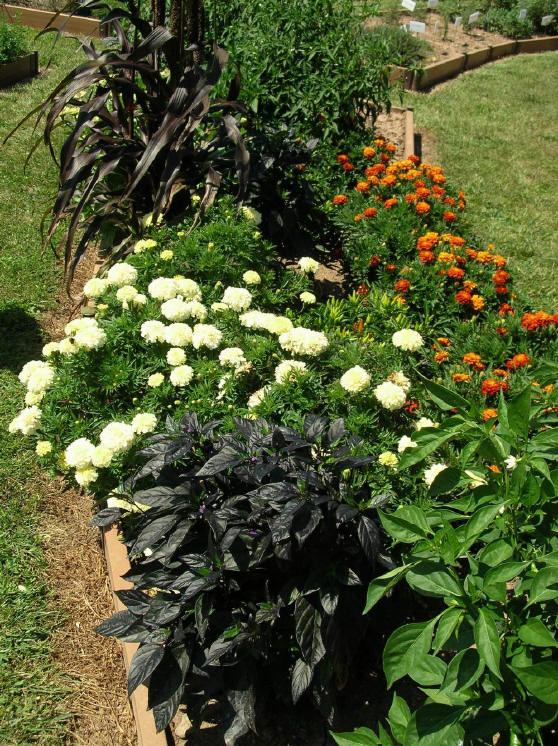Phil Peters
Adams County Master Gardener
 As in the past several years my section of the Penn State Master Gardeners
Trial Gardens is devoted to displaying various varieties of pepper plants that are fit for more than the vegetable garden. All the peppers on display are edible varieties of
Capsicum annuum. They are suitable for planting in containers, or they can be colorful specimens in your home flower garden.
As in the past several years my section of the Penn State Master Gardeners
Trial Gardens is devoted to displaying various varieties of pepper plants that are fit for more than the vegetable garden. All the peppers on display are edible varieties of
Capsicum annuum. They are suitable for planting in containers, or they can be colorful specimens in your home flower garden.
This year you will notice a fair number of flowers in the garden to complement the peppers’ delicate flowers, bold foliage, and colorful fruit. The
flower blossoms are neutral shades of white and subtle lime green. The peppers will provide bright highlights amid the masses of green foliage. Let’s take a look at what you
will see when you visit.
First, the peppers. BLACK PEARL makes a repeat appearance. This is a great accent plant growing 18 inches tall with rich dark purple foliage. Vivid
purple flowers give way to round half inch marble-sized fruit that turns from green to deep purple bordering on black to a brilliant deep crimson by fall. This pepper winters
over well indoors if you have a sunny window.

CANDLELIGHT is a real showman, suitable for border or pot. The 16 inch tall plants fill with white blossoms that produce masses of 2 inch finger-like
peppers that go from green to yellow to orange to fiery red. As it matures all the colors will be displayed at the same time. Candlelight has the heat to give your winter
chili a few more alarms.
Along the same line, with a similar tapered fruit is CHEYENNE. Our plants are much taller, 3 feet, than the 18 inch size in the catalog description.
The fruit will turn from green to a brilliant orange. The fruit packs considerable punch.
Among our larger peppers is KUNG PAO. This will be more recognizable because of its long slender fruit that turns from green to bright red. Ours are
producing 5 to 6 inch fruit that will get a distinctive curl by the time they ripen to their full red color. They are hot and are especially tasty in oriental dishes.
On the mild side check out the ANCHO MAGNIFICO. This is a larger fruit, running 4 and a half to 6 and a half inches in length. It has a bit of a bite.
The pepper is a thick-walled fruit that is suitable for chiles rellenos. They are also great when cleaned, blanched, and frozen. This way they can be enjoyed throughout the
winter.
To illustrate how these plants may be used in the flower garden, I have chosen to set them among some easy-to-grow flowers that will complement the
leaf texture and fruit colors of the pepper plants. Since BLACK PEARL has been such a favorite the past few years, I took it as the starting point. Calling attention to the
pepper’s deep purple/black theme, Purple Majesty Millet from W. Atlee Burpee & Co. immediately draws your eye to the center of the display, the black pearl. Purple Majesty is
a 4 foot tall dark purple plant that produces thousands of seeds on sturdy, long stalks. The grass-like texture of the leaves offers a subtle contrast to the leafy foliage of
the pepper.
Against this vertical attention-getter, BLACK PEARL and CANDLELIGHT are set among common plants with white and pale green flowers. Marigold ‘French
Vanilla’ is a beautiful white flower on 2 foot tall plants. Similar in size is the Zinnia ‘Tequila Lime.’ The flower of this plant is a delicate lime green that bridges the
gap between white and green.
All of these are set behind a row of short border marigolds called ‘Happy Days.’ This variety produces colorful flowers in the usual red/orange range
we associate with the plant. They will echo the orange of the taller CHEYENNE peppers in the middle range of the display.
I set the larger pepper plants, Kung Pao and Ancho Magnifico, out to the side so they would get more sun and to allow the fruit to grow larger. They
could just as well be highlights within a border garden, as they are in my home gardens.
Kung Pao, Cheyenne and Candlelight are ideal for drying to make your own pepper flakes. When the fruit is ripe, cut it leaving a half inch or more of
the stem. I make ristras, or strings, of a dozen or so peppers by stringing them on a heavy thread and hanging them to dry. If you put the needle through the stem, and not
the pepper, you will not damage the fruit nor will you burn your hands. You can also dry them in one of the commercially available vegetable dryers.
When handling all hot peppers wear plastic or rubber gloves. Do not get any of the pepper in your eyes or on sensitive skin. If you try a bite and it
is too hot, drink some milk or eat a slice of bread to take away the sting. Don’t use water, it just spreads the pain!
All the plants in this garden are home grown from seed purchased from leading garden supply catalogs. I start them in the basement and grow them under
lights until the weather warms up.
This is only one of many beautiful garden plots on display at the Agricultural & Home Economics Extension Services, 670 Old Harrisburg Road in
Gettysburg. Come over and see what’s growing.
Read other articles on growing herbs or vegetables
Read other articles by Phillip Peters